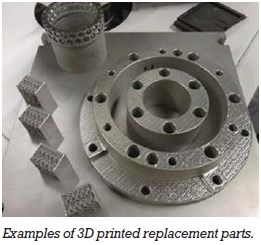The project will be conducted at the GE site in Greenville, South Carolina, USA.

The samples will be 3D printed in metal at the GE Power Advanced Manufacturing Works facility in Greenville, SC and then be shipped to the Idaho National Laboratory (INL). The materials involved are 316L stainless steel and Inconel 718, both of which are used in the light water reactor industry. Once irradiated in INL’s Advanced TestReactor, the samples will be removed, tested and compared to an analysis of unirradiated material conducted by GEH. The results will be used by GEH to support deployment of 3D printed parts for fuels, services and new plant applications. The results of the project are expected to be applicable to both existing and new-build power plants.
Potential for 3D in nuclear industry
“The potential of 3D printing to speed delivery time and reduce the cost of manufacturing performance-enhancing replacement parts for nuclear power plants is quite significant,” said Jay Wileman, President and CEO, GEH. “We want to recognize the Department of Energy for its leadership in advanced nuclear research and we look forward to working with the Idaho National Laboratory.” GEH expects that the industry will see performance, cost and speed benefits for smaller complex parts by utilizing 3D printing technology.
As the size capability increases and the cost decreases, more nuclear power applications are expected to benefit from advanced manufacturing. There is also the potential for composition tailoring using the AM process. As many US nuclear power plants are aging, 3D printing technology will offer another solution for problems such as equipment obsolescence, although larger, thicker parts may be always more cost effective to cast or machine.
Investments in technology

About GE Hitachi Nuclear Energy
Based in Wilmington, N.C., GEH is a world-leading provider of advanced reactors and nuclear services. Established in June 2007, GEH is a part of a global nuclear alliance created by GE and Hitachi to serve the global nuclear industry. The nuclear alliance executes a single, strategic vision to create a broader portfolio of solutions, expanding its capabilities for new reactor and service opportunities. The alliance offers customers around the world the technological leadership required to effectively enhance reactor performance, power output and safety.
By Jon Allen, GE Hitachi Nuclear Energy


